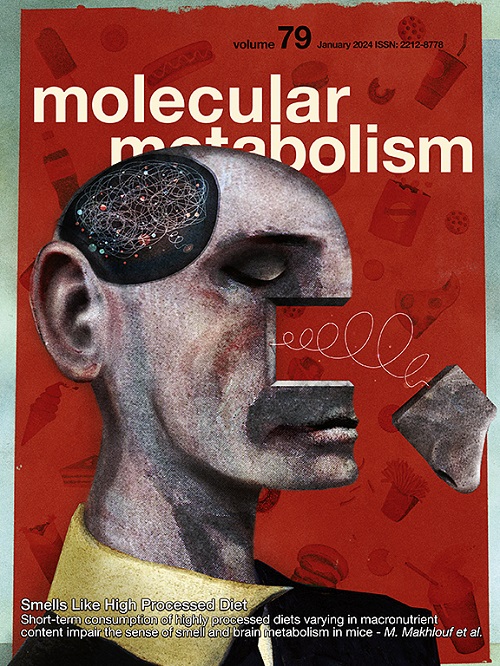新陈代谢传感器 AMPK:十二酶合一。
IF 7
2区 医学
Q1 ENDOCRINOLOGY & METABOLISM
引用次数: 0
摘要
背景:AMP激活蛋白激酶(AMPK)是一种进化保守的能量代谢调节因子。AMPK 对细胞能量状态的急性扰动很敏感,并利用基本的生物能量途径维持细胞平衡。AMPK 是一种由 αβγ 亚基组成的异源三聚体,在人类中由 7 个基因编码(同工酶 α1、α2、β1、β2、γ1、γ2 和 γ3),可形成至少 12 种不同的复合物,具有个性化的生化指纹和组织表达模式。虽然 AMPK 的典型激活机制已经明确,但异源 AMPK 复合物在调控方面的细微和实质性差异仍未得到明确界定:在此,我们利用多学科的研究成果,剖析了AMPK异构体特异性功能的诸多方面以及与健康和疾病的联系。其中包括但不限于腺嘌呤核苷酸和小分子的异生激活、共翻译肉豆蔻酰化和翻译后修饰(尤其是磷酸化)、亚细胞定位管理以及转录网络的控制。最后,我们深入探讨了当前关于 AMPK 是否能形成新型蛋白质复合物(如缺乏 α 亚基的二聚体)的争论,并着重强调了未来具有影响力的研究机会:α1-AMPK的基线活性高于其α2对应物,而且对代谢物和小分子的协同异源激活更敏感。然而,α2复合物对能量应激(即AMP产生)的反应更大,而且似乎是上游LKB1和mTORC1的更好底物。这些差异可能在一定程度上解释了为什么在某些癌症中,α1 是肿瘤启动子,而 α2 是抑制因子。β1-AMPK的活性是通过 "肉豆蔻酰开关 "机制切换的,该机制可能先于一系列信号事件,最终导致ULK1磷酸化,并对小分子或脂肪酸等内源性配体敏感。β2-AMPK并不完全受制于肉豆蔻酰开关,它更倾向于渗入细胞核,我们怀疑这也是它在某些癌症中致癌的原因之一。最后,γ2 和γ3 异构体独特的 N 端延伸是 AMPK 的主要调控域。mTORC1 可直接磷酸化γ2 的这一区域,但这是否是抑制性的,尤其是在疾病状态下,尚不清楚。相反,γ3 复合物可能会在体育锻炼时优先被 mTORC1 靶向。本文章由计算机程序翻译,如有差异,请以英文原文为准。
The metabolic sensor AMPK: Twelve enzymes in one
Background
AMP-activated protein kinase (AMPK) is an evolutionarily conserved regulator of energy metabolism. AMPK is sensitive to acute perturbations to cellular energy status and leverages fundamental bioenergetic pathways to maintain cellular homeostasis. AMPK is a heterotrimer comprised of αβγ-subunits that in humans are encoded by seven individual genes (isoforms α1, α2, β1, β2, γ1, γ2 and γ3), permitting formation of at least 12 different complexes with personalised biochemical fingerprints and tissue expression patterns. While the canonical activation mechanisms of AMPK are well-defined, delineation of subtle, as well as substantial, differences in the regulation of heterogenous AMPK complexes remain poorly defined.
Scope of review
Here, taking advantage of multidisciplinary findings, we dissect the many aspects of isoform-specific AMPK function and links to health and disease. These include, but are not limited to, allosteric activation by adenine nucleotides and small molecules, co-translational myristoylation and post-translational modifications (particularly phosphorylation), governance of subcellular localisation, and control of transcriptional networks. Finally, we delve into current debate over whether AMPK can form novel protein complexes (e.g., dimers lacking the α-subunit), altogether highlighting opportunities for future and impactful research.
Major conclusions
Baseline activity of α1-AMPK is higher than its α2 counterpart and is more sensitive to synergistic allosteric activation by metabolites and small molecules. α2 complexes however, show a greater response to energy stress (i.e., AMP production) and appear to be better substrates for LKB1 and mTORC1 upstream. These differences may explain to some extent why in certain cancers α1 is a tumour promoter and α2 a suppressor. β1-AMPK activity is toggled by a ‘myristoyl-switch’ mechanism that likely precedes a series of signalling events culminating in phosphorylation by ULK1 and sensitisation to small molecules or endogenous ligands like fatty acids. β2-AMPK, not entirely beholden to this myristoyl-switch, has a greater propensity to infiltrate the nucleus, which we suspect contributes to its oncogenicity in some cancers. Last, the unique N-terminal extensions of the γ2 and γ3 isoforms are major regulatory domains of AMPK. mTORC1 may directly phosphorylate this region in γ2, although whether this is inhibitory, especially in disease states, is unclear. Conversely, γ3 complexes might be preferentially regulated by mTORC1 in response to physical exercise.
求助全文
通过发布文献求助,成功后即可免费获取论文全文。
去求助
来源期刊

Molecular Metabolism
ENDOCRINOLOGY & METABOLISM-
CiteScore
14.50
自引率
2.50%
发文量
219
审稿时长
43 days
期刊介绍:
Molecular Metabolism is a leading journal dedicated to sharing groundbreaking discoveries in the field of energy homeostasis and the underlying factors of metabolic disorders. These disorders include obesity, diabetes, cardiovascular disease, and cancer. Our journal focuses on publishing research driven by hypotheses and conducted to the highest standards, aiming to provide a mechanistic understanding of energy homeostasis-related behavior, physiology, and dysfunction.
We promote interdisciplinary science, covering a broad range of approaches from molecules to humans throughout the lifespan. Our goal is to contribute to transformative research in metabolism, which has the potential to revolutionize the field. By enabling progress in the prognosis, prevention, and ultimately the cure of metabolic disorders and their long-term complications, our journal seeks to better the future of health and well-being.
 求助内容:
求助内容: 应助结果提醒方式:
应助结果提醒方式:


